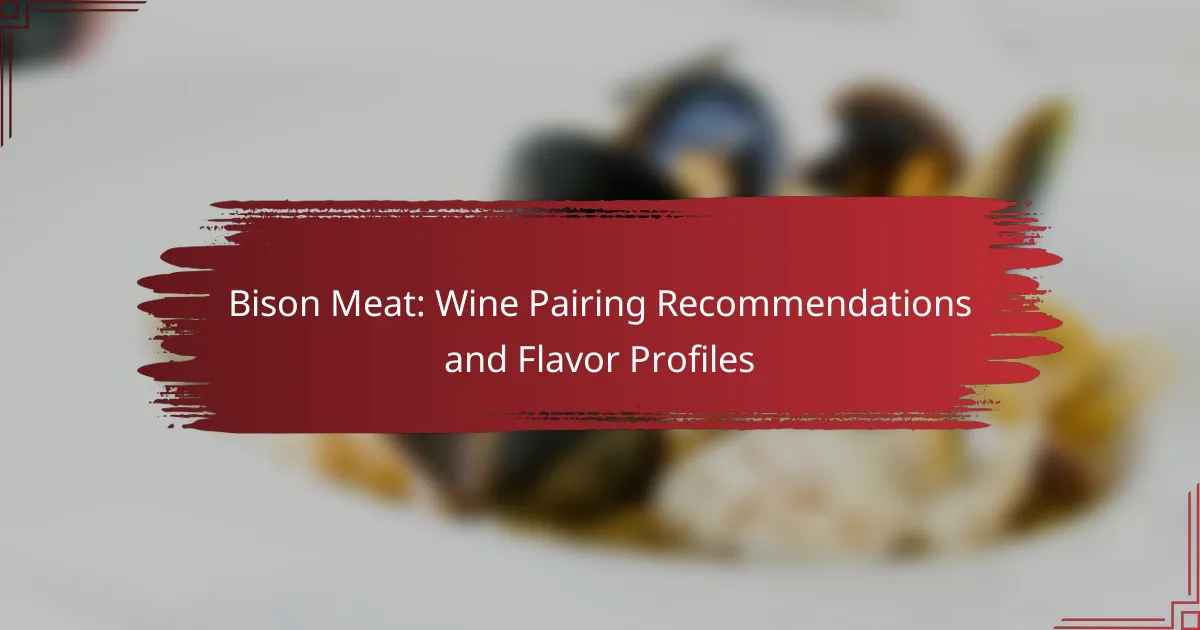Bison burgers offer a delicious alternative to traditional beef, but cooking them requires attention to detail to avoid common pitfalls. Overcooking, excessive seasoning, and neglecting to let the meat rest can result in dry and flavorless patties. To achieve the best flavor and texture, aim for medium-rare to medium doneness and consider enhancing your burger with complementary toppings like creamy avocado or sharp blue cheese.

What are common mistakes when cooking bison burgers?
Common mistakes when cooking bison burgers include overcooking the patties, using excessive seasoning, and not allowing the meat to rest. These errors can lead to dry, tough burgers that lack flavor and juiciness.
Overcooking the patties
Overcooking bison burgers is a frequent mistake that results in a dry texture. Bison is leaner than beef, so it cooks faster and can easily become tough if left on the grill or stovetop too long.
Aim for an internal temperature of around 130-140°F (54-60°C) for medium-rare. Use a meat thermometer to check the temperature, and remove the patties from heat just before they reach your desired doneness, as they will continue to cook slightly while resting.
Using too much seasoning
While seasoning is essential for flavor, using too much can overpower the natural taste of bison. Bison has a rich, slightly sweet flavor that can be masked by heavy spices or salt.
Stick to simple seasonings like salt and pepper, or use a light blend of herbs. A good rule of thumb is to use about half the amount of seasoning you would use for beef, adjusting to taste.
Not letting the meat rest
Failing to let bison burgers rest after cooking is a common oversight. Resting allows the juices to redistribute throughout the meat, resulting in a juicier burger.
Let the patties rest for about 5-10 minutes after cooking. Cover them loosely with foil to keep them warm while they rest, enhancing the overall eating experience.
Choosing the wrong fat content
Selecting the appropriate fat content is crucial for juicy bison burgers. Bison is naturally lean, and using meat that is too low in fat can lead to dry patties.
Look for ground bison with a fat content of around 10-15%. This balance helps retain moisture during cooking while still providing a healthy option compared to higher-fat meats.
Ignoring internal temperature
Ignoring the internal temperature of bison burgers can lead to undercooked or overcooked meat. Since bison is lean, it is important to monitor the temperature closely to ensure safety and quality.
For ground bison, the USDA recommends cooking to an internal temperature of at least 160°F (71°C). Using a digital meat thermometer can help you achieve the perfect doneness without guessing.

How can I properly cook bison burgers?
To properly cook bison burgers, aim for a medium-rare to medium doneness, which allows the natural flavors to shine while ensuring safety. Use appropriate cooking techniques and tools to achieve the best results.
Grilling at medium heat
Grilling bison burgers at medium heat is crucial for even cooking without drying them out. A temperature range of about 350°F to 400°F (175°C to 200°C) is ideal. This allows the burgers to develop a nice sear while keeping the inside juicy.
Ensure your grill grates are clean and preheated before placing the patties on them. This helps prevent sticking and promotes better grill marks.
Using a meat thermometer
Using a meat thermometer is essential for accurately checking the doneness of bison burgers. Aim for an internal temperature of around 130°F to 145°F (54°C to 63°C) for medium-rare to medium. This ensures that the burgers are safe to eat while maintaining their tenderness.
Insert the thermometer into the center of the patty for the most accurate reading. Avoid touching the grill or bone, as this can give a false reading.
Cooking for 4-5 minutes per side
Cooking bison burgers for about 4-5 minutes per side is a good rule of thumb for achieving the desired doneness. This timing may vary slightly based on the thickness of the patties and the heat of the grill. Thicker patties may require additional time.
Keep an eye on the burgers and flip them only once to maintain their juiciness. Over-flipping can lead to dryness and loss of flavor.
Letting patties rest before serving
Letting bison burger patties rest for a few minutes after cooking is important for redistributing the juices. This resting period, typically around 5 minutes, allows the meat to relax and enhances the overall flavor and texture.
Cover the patties loosely with foil during the resting phase to keep them warm. Avoid cutting into them immediately, as this can cause the juices to escape, leading to a drier burger.

What are the best toppings for bison burgers?
The best toppings for bison burgers enhance their rich flavor while adding texture and complementary tastes. Popular choices include creamy avocado, sharp blue cheese, and tangy BBQ sauce, each bringing a unique twist to the burger experience.
Avocado and jalapeños
Avocado adds a creamy texture that balances the lean meat of bison, while jalapeños introduce a spicy kick. Together, they create a delicious contrast that elevates the burger. Consider slicing the avocado and adding fresh jalapeño slices or pickled jalapeños for a milder heat.
When using these toppings, ensure the avocado is ripe for the best flavor. A sprinkle of lime juice can enhance the freshness and prevent browning.
Blue cheese and caramelized onions
Blue cheese provides a bold, tangy flavor that pairs well with the natural sweetness of caramelized onions. This combination creates a rich and savory topping that complements the bison’s robust taste. Use crumbled blue cheese for easy melting and distribution over the burger.
To caramelize onions, cook them slowly over low heat until they become golden brown and sweet, which typically takes around 20 to 30 minutes. This patience pays off with a depth of flavor that enhances your bison burger.
BBQ sauce and coleslaw
BBQ sauce adds a smoky sweetness that contrasts nicely with the savory bison meat, while coleslaw brings crunch and freshness. This combination is particularly popular for outdoor grilling and summer cookouts. Choose a BBQ sauce that matches your flavor preference, whether sweet, tangy, or spicy.
For coleslaw, a simple mix of shredded cabbage and carrots dressed with a vinegar-based or creamy dressing works well. This topping not only adds texture but also balances the richness of the burger.

What equipment do I need for cooking bison burgers?
To cook bison burgers effectively, you’ll need a few essential pieces of equipment that ensure proper cooking and handling. Key tools include a grill or stovetop skillet, a meat thermometer, and a spatula or burger press to shape and flip the patties.
Grill or stovetop skillet
A grill or stovetop skillet is crucial for cooking bison burgers. Grilling imparts a smoky flavor, while a skillet allows for better control over the cooking temperature. Both methods can yield delicious results, but grilling typically requires more attention to avoid overcooking.
When using a grill, preheat it to medium-high heat, around 375°F to 400°F (190°C to 200°C). For stovetop cooking, use medium heat and ensure the skillet is well-oiled to prevent sticking. Aim for a cooking time of about 4 to 6 minutes per side, depending on the thickness of the patties.
Meat thermometer
A meat thermometer is essential for ensuring that bison burgers are cooked safely and to the desired doneness. Bison is leaner than beef, so it can dry out quickly if overcooked. The USDA recommends cooking ground bison to an internal temperature of 160°F (71°C).
Insert the thermometer into the center of the patty to get an accurate reading. If you’re aiming for a medium-rare burger, consider cooking it to about 145°F (63°C) but be aware of food safety guidelines. Always let the burgers rest for a few minutes after cooking to allow juices to redistribute.
Spatula and burger press
A spatula is necessary for flipping bison burgers without breaking them apart. Choose a sturdy spatula with a wide surface area to support the patty during the flip. A burger press can also be helpful for shaping uniform patties, which ensures even cooking.
When using a burger press, aim for patties that are about ¾ to 1 inch thick. This thickness helps maintain juiciness while cooking. Avoid pressing down too hard when flipping; gentle handling keeps the burgers intact and flavorful.

How do I choose the right bison meat?
Choosing the right bison meat involves selecting high-quality cuts that enhance flavor and nutrition. Focus on sourcing grass-fed options and lean cuts to ensure a healthier and tastier burger experience.
Look for grass-fed options
Grass-fed bison is generally considered superior due to its higher omega-3 fatty acid content and lower fat levels compared to grain-fed alternatives. When shopping, look for labels indicating “grass-fed” or “pasture-raised” to ensure you are getting the best quality meat.
Additionally, grass-fed bison often has a richer flavor profile, making it ideal for burgers. Many local farms and specialty butcher shops offer grass-fed bison, so consider supporting local producers for fresher options.
Check for lean cuts
When selecting bison meat, opt for lean cuts such as sirloin, tenderloin, or ground bison. These cuts provide a great balance of flavor and lower fat content, making them healthier choices for burgers.
Be cautious of cuts labeled as “extra lean,” as they may lack the necessary fat for a juicy burger. Aim for cuts with around 10-15% fat content for optimal taste and texture. Always check the packaging for fat percentages and choose accordingly.



